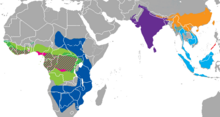
Back آكل النمل الحرشفي Arabic پانجولين ARZ বন-ৰৌ Assamese Pholidota AST Vorbumoldunol (Pholidota) AVK فولیدوتا AZB Klesih BAN Balintong (hayop) BCL Пангаліны Byelorussian Пангаліны BE-X-OLD
| Tenggiling | |
|---|---|

| |
| Tenggiling India | |
| Pengelasan saintifik | |
| Alam: | |
| Filum: | |
| Kelas: | |
| Order: | Pholidota Weber, 1904
|

| |
| Taburan spesies yang masih wujud | |
| Sinonim | |
|
Senarai sinonim:
| |
Tenggiling, senggiling atau pengguling ialah spesies mamalia dalam order Pholidota. Order ini mempunyai satu keluarga yang masih wujud, keluarga Manidae terdiri daripada genus Manis, genus Phataginus, dan genus Smutsia.[5] Genus Manis mempunyai empat spesies yang ditemukan di Asia, manakala genus-genus Phataginus dan Smutsia masing-masing mempunyai dua spesies yang ditemukan di Afrika sub-Sahara.[6]
Tubuh badannya dipenuhi sisik keras dan tajam. Apabila ia merasa dalam keadaan berbahaya, ia akan menggulungkan tubuhnya menjadi seperti bola untuk mempertahankan diri daripada pemangsa.[7][8]
- ^ Springer, Mark S.; Emerling, Christopher A.; Gatesy, John; Randall, Jason; Collin, Matthew A.; Hecker, Nikolai; Hiller, Michael; Delsuc, Frédéric (Disember 2019). "Odontogenic ameloblast-associated (ODAM) is inactivated in toothless/enamelless placental mammals and toothed whales". BMC Evolutionary Biology. 19 (1): 31. doi:10.1186/s12862-019-1359-6. PMC 6343362. PMID 30674270.
- ^ Zagorodniuk, I. (2008). "Scientific names of mammal orders: from descriptive to uniform". Visnyk of Lviv University. Biology (48): 33–43.
- ^ Cope, E. D. (1889). "The Edentata of North America". American Naturalist. 23 (272): 657–664.
- ^ Pearse, Arthur Sperry (1936). Zoological names. A list of phyla, classes, and orders, prepared for section F, American Association for the Advancement of Science. Duke University Press. m/s. 24.
- ^ Schlitter, Duane A. (2005). Wilson, D.E.; Reeder, D.M. (penyunting). Mammal Species of the World: A Taxonomic and Geographic Reference (ed. ke-3). Baltimore, Maryland, Amerika Syarikat: Johns Hopkins University Press. m/s. 530. ISBN 978-0-8018-8221-0.
- ^ Gaudin, Timothy (28 Ogos 2009). "The Phylogeny of Living and Extinct Pangolins (Mammalia, Pholidota) and Associated Taxa: A Morphology Based Analysis" (PDF). Journal of Mammalian Evolution. Heidelberg, Jerman: Springer Science+Business Media. 16 (4): 235–305. doi:10.1007/s10914-009-9119-9. S2CID 1773698. Diarkibkan daripada yang asal (PDF) pada 25 September 2015. Dicapai pada 14 Mei 2015.
- ^ Wang, Bin; Yang, Wen; Sherman, Vincent R.; Meyers, Marc A. (2016). "Pangolin armor: Overlapping, structure, and mechanical properties of the keratinous scales". Acta Biomaterialia. Oxfordshire, England: Elsevier. 41: 60–74. doi:10.1016/j.actbio.2016.05.028. PMID 27221793.
- ^ Dr. Ahmad Ismail (12 Januari 2018). "Tenggiling haiwan terancam". Utusan Malaysia. m/s. 20 – melalui Universiti Putra Malaysia Institutional Repository.